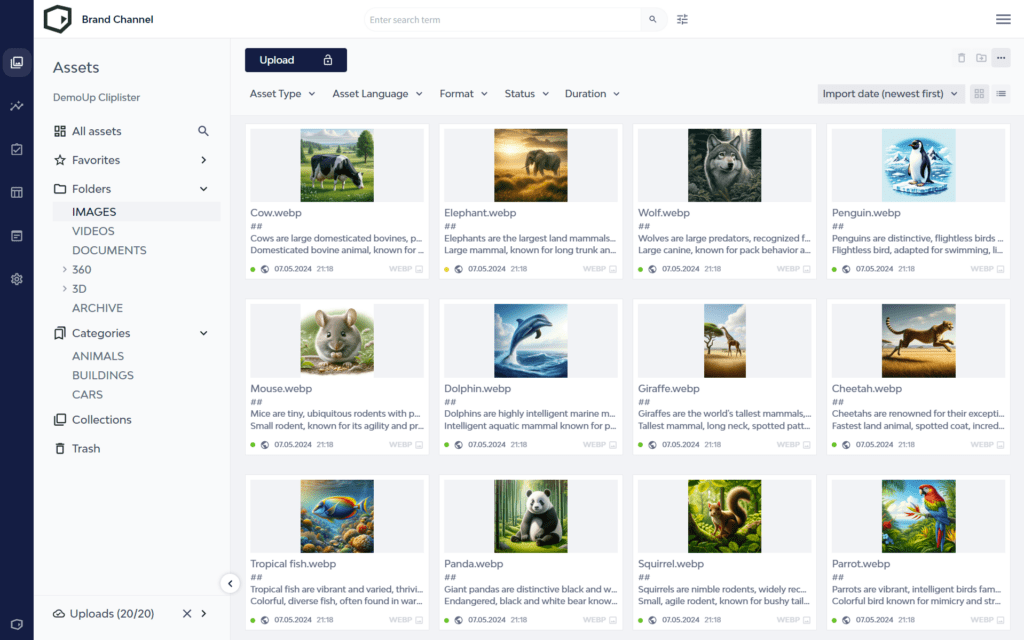7 Strategies to Manage Brand Assets Like a Pro
Digital Asset Management
Updated on February 13, 2025
If we asked you what your company’s most valuable asset was, what would it be? Your clients and employees? They come and go. Your IT hardware? Will be outdated in a few years.
But what about your brand? The world’s biggest and best have outlasted generations, economic depressions, and even world wars. So how do they do it?
Enter brand asset management.
The way you manage brand assets is essential to your company’s identity and has a direct impact on your revenue stream.

Get Your Free Digital Asset Management Playbook!
Download NowThat’s why some of the world’s biggest brands – think Adidas, McDonald’s, Apple, and Nintendo – have reputations for pursuing legal action against anyone and everyone that threatens their marque’s value.
And rightly so. These companies didn’t generate their billion dollar/pound/euro values overnight – so it makes sense they want to maintain full control over how their branding is used.
It’s also why companies like Starbucks have comprehensive brand guidelines and media kits to prevent misuse and misrepresentation.
The rest of this blog post covers seven asset management strategies used by the world’s top brands. Read on to learn how to implement them.
1. Utilise Brand Asset Management Software

Businesses must control brand assets to maintain brand identity and efficient across different platforms.
These tools are essential for storing, organising and delivering brand assets, which have become the fundamentals of BAM software and platforms.
Choosing the right BAM software requires careful consideration of your company’s specific needs and processes.
For some, building a stack of tools may be more effective than one standalone solution. This provides you flexibility when it comes to specific features and requirements.
For instance, at DemoUp Cliplister, we provide brands the ability to control content on the PDPs at online shops – a feature nobody else can offer as part of an asset management framework.
Reviewing Brand Asset Management Software & Platforms
BAM is ideal for organisations who must manage brand assets effectively in various media.
They include centralised asset management, customised brand guidelines, collaborative tools, analytical reports and integrations, among other features.
Using such software will make sure that your brand is recognised on all relevant channels, increase productivity, promote collaboration, and beat the competition.
Best Brand Asset Management Software on the Market
Several leading platforms stand out as the best digital and brand asset management software. Each known for their particular characteristics and functionalities.
Here are some top features and benefits to look for:
Key Features of the Best Brand Management Software
When choosing a brand management software, businesses should consider the following features:
- GUI: Having an interface that’s easy to navigate by all team members.
- Customisable Brand Guidelines
- Centralised Asset Management: A centre where a company can keep all its assets associated with its brands and make them available to everyone.
- Collaboration Tools
- Analytics & Reporting
- Integration with Other Digital Tools
- Reliable Customer Support
Benefits of Using a Brand Asset Management System
There are many advantages to using a brand asset management system. Some of these include:
- Higher Team Efficiency and Output
- Better Cooperation
- Enhanced Brand Governance and Exposure
- Competitive Edge
- Capability for growth
2. Centralise Storage and Organisation

An organised system not only keeps your digital workspace clean but also improves accessibility, efficiency and production. This can be done via a digital asset management system.
Digital asset management is the process of providing structure and organisation to your digital files.
Here are some professional techniques for managing brand assets like a pro:
Organise by Domain, not Function
The time has come to stop organising things based on their asset types; i.e., images, videos, and the like.
The new rule is to group them according to domains.
This means organising your folder hierarchy at the top level based on specific teams, product lines, or thematic divisions rather than mere separation of photos and videos.
For example, assets could be broken out into categories such as “Shirts,” “Hats,” or “Brand”, under which they align with different product lines or target audience segments.
Adopt a Consistent Folder Structure
Uniformity is another important aspect of an efficient organisation system. All projects have a similar folder structure to enable logical and intuitive discovery of assets among team members.

To make searching easier and workflow simpler, consider using names like “Reference” for inspiration, “Working Files” for ongoing edits, and “Finals” for completed versions.
Eliminate Excess Subfolders
Avoid the pitfall of having many subfolders pertaining to different versions or aspects of a resource.
For instance, when you do not categorise assets based on dimensions or versions like 800×800 or 1200×1200, you eliminate extra complications and improve accessibility.
By centralising asset management and housing project-related conversations in one tool, confusion can be avoided, as can improved workflow efficiency.
Adopt Centralised Asset Management
For smooth organisation and collaboration, it’s important to have all digital resources in one place. By merging all the assets together with information related to projects into one platform, there will be ease of reach by human personnel involved in teamwork.
3. Implement Consistent Branding Guidelines

Implementing consistent branding guidelines is essential to manage brand assets effectively and maintain a cohesive brand presence across all channels.
Here are some ways you can manage brand assets like a pro, starting with developing clear brand guidelines and style guides.
- Design a brand logo and create guidelines for placement and usage.
- Pick a brand colour palette: Select a set of colours that reflect your brand’s personality and values.
- Choose brand fonts that reflect your unique identity.
- Select branded iconography that represents your niche.
- Set photography style guidelines: Define a specific photography style that aligns with your brand aesthetic. Provide a library of brand-approved photos and images for consistency in visual storytelling.
- Collect web-specific brand elements: Include illustrations, animations, and stickers that are tailored for digital platforms to maintain brand consistency online.
- Put together brand guidelines in a shareable format.
4. Streamline Approval Processes
From global organisations with multiple regions and sub-brands to smaller companies with distinct brand variations, ensuring the correct and consistent usage of brand assets can be a daunting task.
Fortunately, there are strategies you can put in place to streamline approval processes and reduce costly revision rounds.
The first step in streamlining approval processes is to establish comprehensive brand guidelines that show, as well as tell, how to use different brand assets.
After you establish your brand guidelines and platform, you can integrate digital asset management functionality to take advantage of features like version control and user permissions.

Additionally, DAM systems can automate workflow processes to ensure all team members follow the same guidelines and procedures.
The system can also provide templates for different marketing materials, making it easy for team members to create materials that are consistent with the brand’s messaging and identity.
5. Leverage Collaboration Tools
In brand management, leveraging collaboration tools has become an essential strategy to ensure the efficient management of brand assets.
These tools make it easier for organisations to maintain a cohesive brand identity across various channels and platforms.
Let’s explore which key team members are likely to benefit the most from these tools:
Brand Managers
Brand managers – whose titles even contain the words “brand” and “manage” – are tasked with upholding and nurturing the brand’s identity and reputation.
These professionals heavily rely on brand management tools to maintain consistency in brand presentation across all touchpoints, streamline workflows, and track brand performance metrics.
Brand managers utilise tools such as digital asset libraries, style guides, and analytics platforms to monitor the health of the brand and make informed, data-driven decisions that enhance brand value and customer engagement.
Marketing Teams
Effective brand management is crucial for marketing teams to communicate the brand’s message consistently and engage with customers effectively.

Tools such as content calendars, social media management platforms, and brand monitoring tools help measure campaign impact and maintain customer loyalty.
Sales Representatives
Sales representatives are responsible for driving revenue by selling the brand’s products or services to customers.
Digital asset and brand management tools help them access up-to-date product information, brand messaging, and sales collateral to support their sales efforts.
Brand Collaborators
External partners and brand collaborators who collaborate closely with the brand to promote or distribute products and services also benefit from brand management tools.
These collaborators use brand management tools to ensure alignment with the brand’s values, messaging, and visual identity.
Co-branding guidelines, project management platforms, and brand asset portals are key tools utilised by partners and collaborators to maintain brand consistency, strengthen partnerships, and enhance the brand experience for mutual customers.
6. Monitor and Update Brand Assets Regularly
Brands are the cornerstone of a company’s identity and can significantly impact its success and growth.
In today’s dynamic market, consistently monitoring and updating brand assets is crucial for staying relevant and competitive.
This section will explore the importance of conducting regular audits of existing brand assets and explore strategies to effectively manage them.
Importance of Conducting Regular Audits of Existing Brand Assets
Conducting a brand audit offers several benefits that are vital for the success of a brand.
Firstly, it helps in identifying areas for improvement within existing brand assets. This could include outdated messaging, inconsistent visual elements, or misalignment with the current market trends.

Get Your Free Digital Asset Management Playbook!
Download NowMoreover, a brand audit ensures consistency across all touchpoints, instilling trust and recognition among target audiences.
Additionally, conducting regular brand audits enables companies to gain valuable competitive insights, providing a strategic advantage in the market.
Ways to Keep Brand Materials and Digital Assets Up to Date
Companies can adopt several strategies to keep brand materials and digital assets up to date.
First, it’s essential to establish a clear process and timeline for reviewing and updating brand assets. Include regular reviews of brand guidelines, visual assets, and messaging to ensure aligment with current brand positioning and market trends.
Additionally, leveraging technology and automation tools can streamline the process of updating digital assets, ensuring efficiency and accuracy.
Moreover, seeking feedback from key stakeholders and customers can provide valuable insights for updating brand materials and digital assets, making them more relevant and impactful.
The Use of Version Control to Manage Changes and Updates

Version control is a critical aspect of managing changes and updates to brand assets.
It involves systematically managing changes to documents, designs, and digital assets to ensure consistency and accuracy.
Utilising version control tools allows companies to track changes, manage multiple versions of assets, and prevent unwanted losses.
This ensures that all updates and modifications to brand assets are well-documented and reversible if necessary.
Additionally, version control facilitates efficient approval processes, reducing the risk of errors and inconsistencies in brand materials.
7. Implement a Regular Training Schedule
Staying ahead of the curve is crucial for businesses to thrive.
One way to ensure continuous growth and development is by implementing a regular brand management training schedule.
This section will explore the importance of brand management training and how it can help professionals build a strong brand identity, enhance customer perception, drive business growth, navigate crisis management, and adapt to digital transformation.
Building a Strong Brand Identity
A clear and compelling brand identity serves as the foundation for all marketing efforts.
Brand management training plays a crucial role in teaching professionals how to craft a cohesive brand story that resonates with their target audience.

This includes defining brand values, mission, vision, and visual elements that communicate the brand’s essence effectively.
By honing these skills through training, professionals can create a strong and memorable brand identity that sets them apart from the competition.
Enhancing Customer Perception
Customer perception is a determining factor in the success of any business. A cohesive brand image builds credibility with your audience.
This, in turn, leads to increased customer loyalty and advocacy, driving long-term success and sustainability.
Driving Business Growth
Your brand is instrumental in attracting and retaining customers, ultimately driving business growth.
Brand management training goes beyond the basics of branding and looks into understanding market trends, customer behaviour, and competitive analysis.
Arming your teams with these insights through brand management training enables the development of marketing strategies to fuel business growth.
Navigating Crisis Management
No brand is immune to challenges and crises.
Effective brand management training prepares professionals to handle crises confidently and efficiently.
Conducting training on crisis communication plans and strategies helps you manage adverse situations while safeguarding your reputation.
Adapting to Digital Transformation
In today’s digital age, brands must adapt and evolve to stay relevant.
Brand management training with a strong focus on digital marketing equips professionals with the latest tools, technologies, and strategies to navigate the digital landscape successfully.
By staying abreast of digital trends and best practices, businesses can leverage digital channels to reach their audience effectively and drive business growth in the digital era.
Ways to Share Updates With Your Team
To ensure that the knowledge gained through brand management training is effectively disseminated within the organisation, companies can utilise various communication channels.
Some effective ways to share updates with the team include:
- Stand-up Meetings: Brief, daily meetings that keep the team informed about progress and challenges.
- Check-in Meetings: Regular check-in meetings for team members to share updates and discuss ongoing projects.
- Status Updates: Periodic status updates via email or shared documents keep the team informed about key initiatives.
- Video Updates: Engaging video updates from leadership or training sessions can effectively communicate important information.
- Workplace Communication Channels: Utilise digital communication platforms like Slack or Microsoft Teams to share updates and facilitate discussions among team members.
Wrapping Up
A well-defined brand asset management strategy not only helps businesses streamline branding efforts but also ensures consistency, efficiency, and maximum impact across all touchpoints.
This consistency reinforces brand recognition, builds trust with customers, and cultivates strong brand identity that resonates with the target audience.
The seven strategies outlined above – from defining brand values and enhancing customer perceptions, to driving business growth, navigating crises, and adapting to digital transformation – help organisations maximise the value of brand assets and their impact in the marketplace.
Integrating them into a brand asset management plan can position your business for long-term success, growth, and sustainability.

Frequently Asked Questions
Now that we’ve covered the important information regarding managing brand assets, here are answers to a few frequently asked questions.
For more on digital and brand asset management, check out the blog.
Or, visit the homepage to see our full product portfolio.
Having a strategy for managing digital brand assets is crucial as it ensures consistency, efficiency, and effectiveness in how a brand is presented online. It helps maintain brand integrity, enhances customer engagement, and strengthens brand recognition in the digital landscape.
Software plays a crucial role in brand management by providing tools for centralising, organising, and accessing brand assets. It enables efficient asset storage, retrieval, and distribution, ensuring brand consistency, enhancing collaboration, and streamlining marketing activities across various channels.
Approval processes are essential in managing brand assets, as they enable efficient review and approval workflows, ensuring compliance with brand guidelines and legal requirements. They help maintain brand integrity, minimise errors and inconsistencies, and ensure all content aligns with the brand’s messaging and values.
The responsibility for brand management usually falls on the marketing team, led by a head of marketing or a chief marketing officer. However, other departments, such as creative, design, and communications teams, may also be involved in managing and maintaining the brand identity across various touchpoints and channels.
Better Content. More Sales.

Fill out the form to discover our end-to-end eCommerce content solutions for brands & shops




